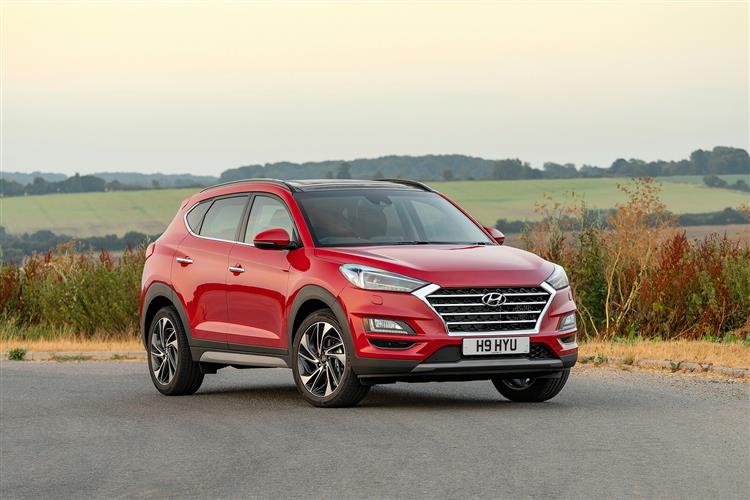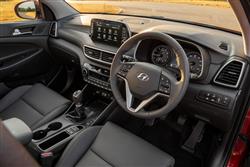How will you view?
This is a sample, showing 30 seconds of each section.
MEET YOU IN TUCSON? (some text hidden) SECTIONED_new_hyundaitucson_2019
By Jonathan Crouch
Introductionword count: 43
Back in 2018, Hyundai were aiming high with this improved 'TL'-series version of their stylish Tucson, a sharp-suited family mid-sized SUV aimed at the Qashqai-class. We're told it'll 'change the way you drive': it's certainly changing this Korean brand's fortunes in this sector.
Modelsword count: 18
Models Covered: 5dr SUV (1.6 Gdi, 11.6 T-Gdi / 1.7 CRDi, 1.6 CRDi, 2.0 CRDi, 2.0 CRDi 48V)
Historyword count: 325
In an era where nearly a quarter of all European car buyers are looking at something from the SUV Crossover class, mainstream brands need to take this segment very seriously. Hyundai's been doing just that with this car, the Tucson. In this 'TL'-series form, it was originally launched in 2015, but here, we're looking at the much improved version of that car that the brand introduced in 2018. Hyundai has been offering Crossovers in the mid-sized 'Qashqai'-class SUV 'C'-segment since the first generation 'JM'-series Tucson sold between 2004 and 2009. That contender was replaced by a far more competitive 'LM'-series model, which the brand chose to badge 'ix35' for Europe and which campaigned until the original version of this 'TL'-series design made its debut - at which point the 'Tucson' badge re-appeared. This more recent Tucson did well for the brand, with over 600,000 sales in its first three years on sale, thanks to higher quality, extra technology, greater standards of safety, more space and sharper driving dynamics. As part of the mid-term update we're going to look at here, quite a lot was changed to improve it. Buyers were offered an all-new entry-level diesel engine and even the option of mild hybrid diesel technology for the first time. In addition, there were smarter looks, more safety kit and extra media connectivity. Plus original customers could, with this facelifted model, have features that used to be the preserve of bigger luxury SUVs - things like full-LED headlights, adaptive cruise control and a surround view camera system. Mind you, from new, this Hyundai was priced to reflect that level of prowess, the Korean brand by 2018 having long abandoned its bargain basement beginnings. Can what's on offer in this improved 'TL'-series model make sense on the used market if you're looking for a mid-sized family SUV from the 2018-2020 period? And offer a genuine alternative to the established players in this sector? Time to find out.
What You Getword count: 373
More than anything else, it's probably the design of this Tucson that will do most to interest SUV buyers browsing models from the 2018-2020 era in the mid-sized segment. The styling here was clearly inspired by the brand's larger and very good looking Santa Fe SUV and, with flowing surfaces, bold proportions and sharp lines, delivers one of the more attractive cars in this class from this period. Take a seat behind the wheel and you get the commanding view over the traffic that SUV drivers like so much in a cabin that's smart and logically laid out. For this revised model, the brand redesigned the upper dashboard, using higher-quality materials with a double-stitching line. As with the original version of this 'TL'-series design, the focal point of the centre console is a 'floating' infotainment system screen, which is 7-inches in size with entry-level trim but 8-inches in size elsewhere in the range. Either way, 'Apple CarPlay' and 'Android Auto' 'Phone Projection' smartphone-mirroring is provided. It's a touchscreen monitor with the usual DAB audio, Bluetooth and informational functions, plus it features voice control and physical shortcut buttons that make it easy to quickly change between various functions. And the rear seat? Well fortunately, the rearward-sloping roof doesn't really impede access that's aided by the wide-opening doors. Take a seat in the back and it's pretty spacious by class standards. If you've previously owned or test driven a rival comparably-priced Qashqai or Ateca, you should notice how much extra leg room is freed up by this Hyundai's slightly lengthier body. As usual though in this sector, a trio of adults will certainly need to be on familiar terms over longer trips. Rear passengers will also appreciate the provision of their own air vents, the seat heating you get on top models and the fact that the seat backs recline for greater comfort on longer journeys. And out back? Well raise the tailgate - a little disappointingly, it's only electrically-powered with the very priciest models - and you'll find that boot space is about average by class standards. It varies a bit depending on the engine you choose. Petrol models offer 513-litres, the 1.6-litre diesel has 484-litres and the mild hybrid 2.0-litre diesel offers 459-litres.
To see the full road test text contact us on 0330 0020 227
Pictures (high res disabled)

.jpg)
|
.jpg)
|
.jpg)
| |||
.jpg)
|
.jpg)
|
.jpg)
| |||
.jpg)
|

|
Scoring (subset of scores)
Category: Crossover or SUV 4x4s
| Performance | |
| Handling | |
| Comfort | |
| Space | |
| Styling, Build, Value, Equipment, Depreciation, Handling, Insurance and Total scores are available with our full data feed. | |



